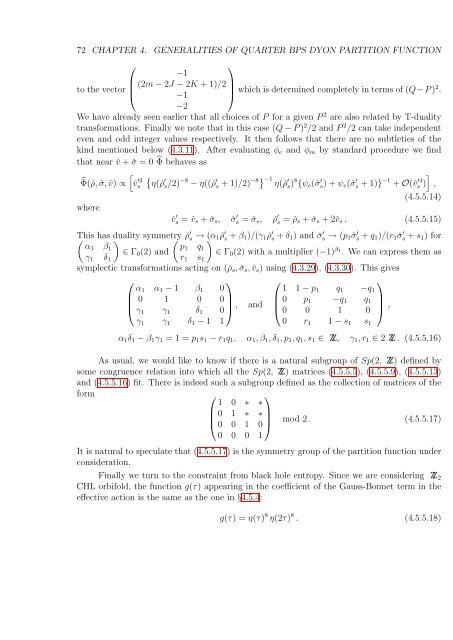PHYS08200604018 Shamik Banerjee - Homi Bhabha National ...
PHYS08200604018 Shamik Banerjee - Homi Bhabha National ...
PHYS08200604018 Shamik Banerjee - Homi Bhabha National ...
Create successful ePaper yourself
Turn your PDF publications into a flip-book with our unique Google optimized e-Paper software.
72 CHAPTER 4. GENERALITIES OF QUARTER BPS DYON PARTITION FUNCTION<br />
⎛<br />
⎞<br />
−1<br />
to the vector ⎜ (2m − 2J − 2K + 1)/2<br />
⎟<br />
⎝ −1 ⎠ which is determined completely in terms of (Q−P )2 .<br />
−2<br />
We have already seen earlier that all choices of P for a given P 2 are also related by T-duality<br />
transformations. Finally we note that in this case (Q − P ) 2 /2 and P 2 /2 can take independent<br />
even and odd integer values respectively. It then follows that there are no subtleties of the<br />
kind mentioned below (4.3.11). After evaluating φ e and φ m by standard procedure we find<br />
that near ˇv + ˇσ = 0 ̂Φ behaves as<br />
[ {<br />
̂Φ(ˇρ, ˇσ, ˇv) ∝ ˇv s<br />
′2 η(ˇρ<br />
′<br />
s /2) −8 − η((ˇρ ′ s + 1)/2) −8} ]<br />
−1<br />
η(ˇρ<br />
′<br />
s ) 8 {ψ e (ˇσ s) ′ + ψ e (ˇσ s ′ + 1)} −1 + O(ˇv s ′4 ) ,<br />
(4.5.5.14)<br />
where<br />
ˇv s ′ = ˇv s + ˇσ s , ˇσ s ′ = ˇσ s , ˇρ ′ s = ˇρ s + ˇσ s + 2ˇv s . (4.5.5.15)<br />
( This has duality ) symmetry ( ˇρ ′ s → )(α 1 ˇρ ′ s + β 1 )/(γ 1 ˇρ ′ s + δ 1 ) and ˇσ s ′ → (p 1ˇσ s ′ + q 1 )/(r 1ˇσ s ′ + s 1 ) for<br />
α1 β 1<br />
p1 q<br />
∈ Γ<br />
γ 1 δ 0 (2) and<br />
1<br />
∈ Γ<br />
1 r 1 s 0 (2) with a multiplier (−1) β 1<br />
. We can express them as<br />
1<br />
symplectic transformations acting on (ˇρ s , ˇσ s , ˇv s ) using (4.3.29), (4.3.30). This gives<br />
⎛<br />
⎞ ⎛<br />
⎞<br />
α 1 α 1 − 1 β 1 0<br />
1 1 − p 1 q 1 −q 1<br />
⎜ 0 1 0 0<br />
⎟<br />
⎝ γ 1 γ 1 δ 1 0 ⎠ , and ⎜ 0 p 1 −q 1 q 1<br />
⎟<br />
⎝ 0 0 1 0 ⎠ ,<br />
γ 1 γ 1 δ 1 − 1 1<br />
0 r 1 1 − s 1 s 1<br />
α 1 δ 1 − β 1 γ 1 = 1 = p 1 s 1 − r 1 q 1 , α 1 , β 1 , δ 1 , p 1 , q 1 , s 1 ∈ Z, γ 1 , r 1 ∈ 2 Z . (4.5.5.16)<br />
As usual, we would like to know if there is a natural subgroup of Sp(2, Z) defined by<br />
some congruence relation into which all the Sp(2, Z) matrices (4.5.5.5), (4.5.5.9), (4.5.5.13)<br />
and (4.5.5.16) fit. There is indeed such a subgroup defined as the collection of matrices of the<br />
form<br />
⎛<br />
⎞<br />
1 0 ∗ ∗<br />
⎜ 0 1 ∗ ∗<br />
⎟<br />
⎝ 0 0 1 0 ⎠ mod 2 . (4.5.5.17)<br />
0 0 0 1<br />
It is natural to speculate that (4.5.5.17) is the symmetry group of the partition function under<br />
consideration.<br />
Finally we turn to the constraint from black hole entropy. Since we are considering Z 2<br />
CHL orbifold, the function g(τ) appearing in the coefficient of the Gauss-Bonnet term in the<br />
effective action is the same as the one in §4.5.4:<br />
g(τ) = η(τ) 8 η(2τ) 8 . (4.5.5.18)

















